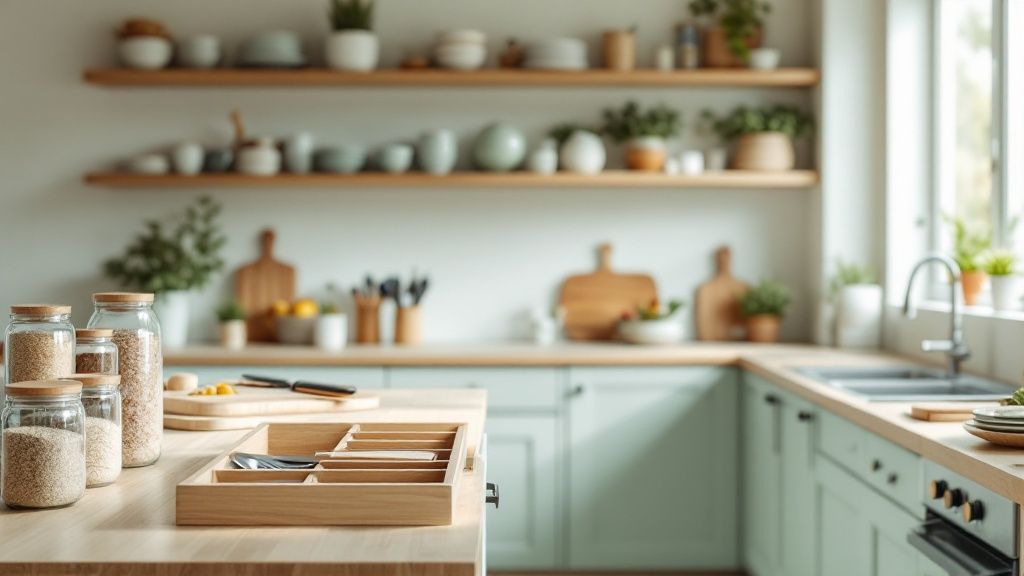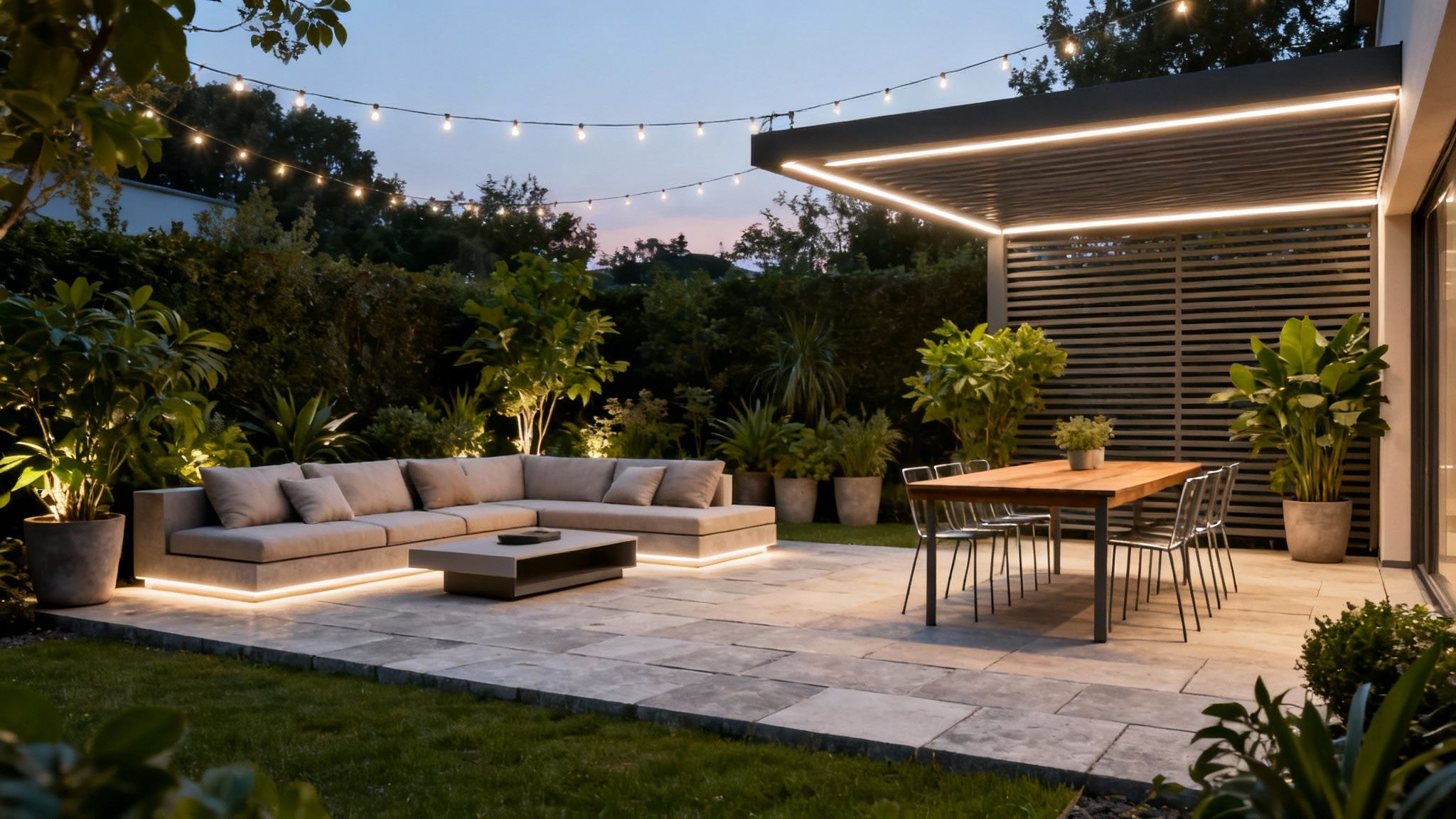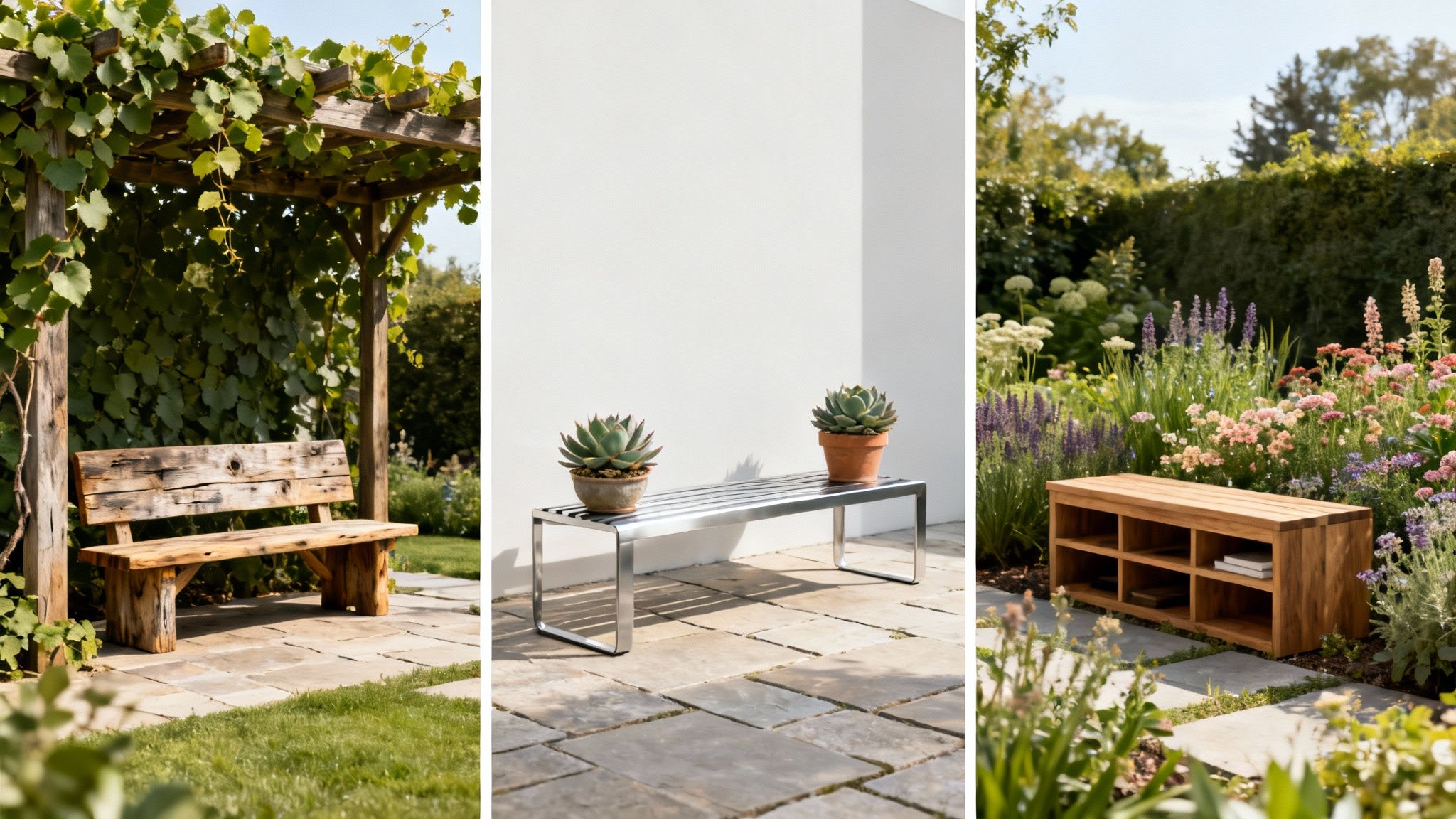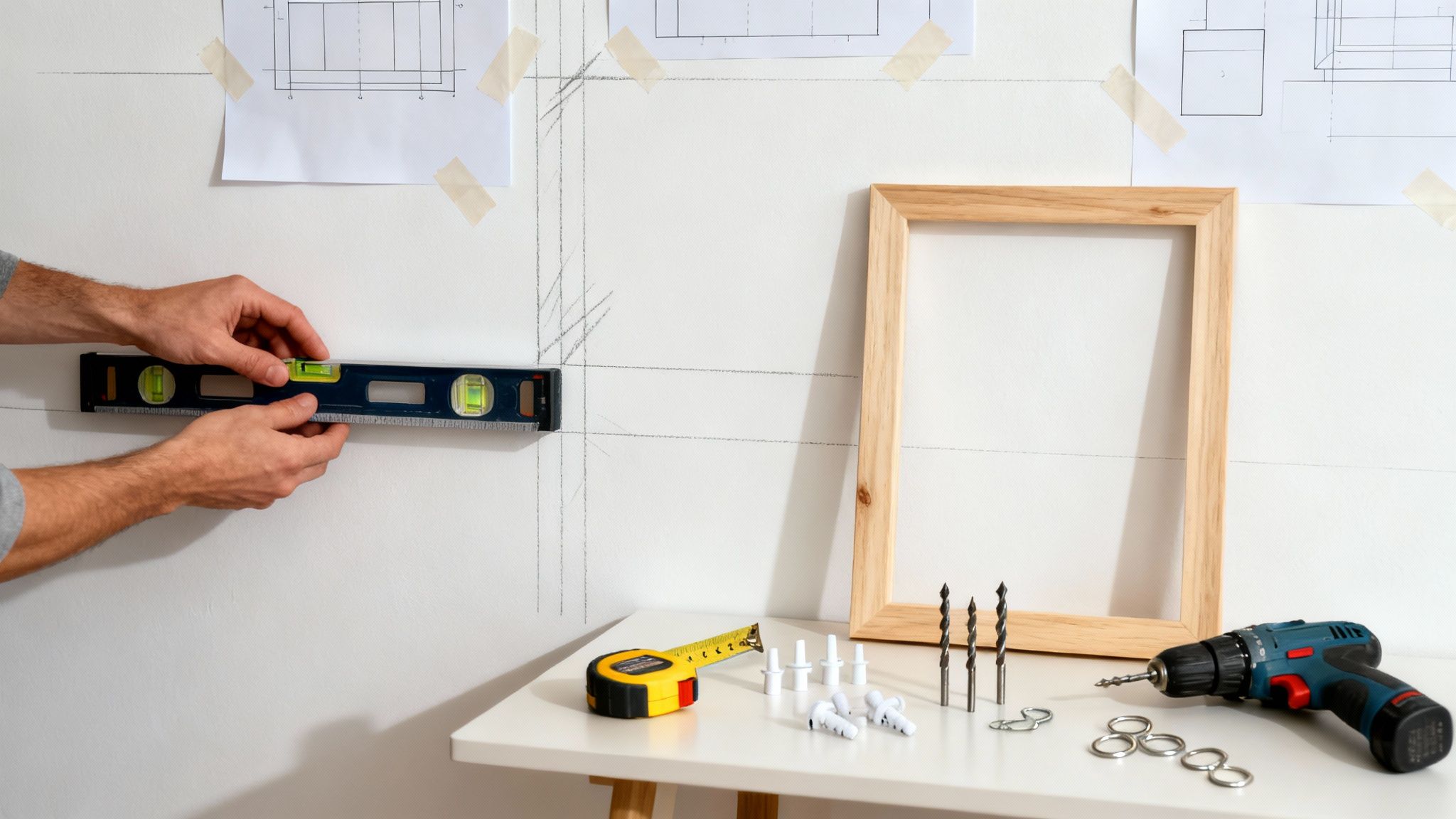Knowing how to organise your kitchen really comes down to four core ideas: a bit of ruthless decluttering, clever zoning, savvy storage, and building habits that stick. Once you get these right, you can transform a chaotic space into a place that actually feels calm and works for you. It's not about being perfect, it's about creating a system that fits your real life.
Your Path to a Calm and Efficient Kitchen
Picture a kitchen where everything has a home, making a meal feels straightforward, and you can grab what you need without a second thought. That kind of easy, efficient space is much closer than you might think. Don't worry about that overwhelming feeling of not knowing where to begin; I'll walk you through a clear plan to turn your kitchen from a source of stress into the functional heart of your home.
This guide goes beyond the usual tips you've probably heard before. It’s packed with practical strategies that work in real UK homes, whether you're navigating a small city flat or a sprawling family kitchen. After all, the modern kitchen is so much more than a place to cook; it's the central hub for family life. If you're interested in how this has changed over time, you can read more about the rise of the living kitchen.
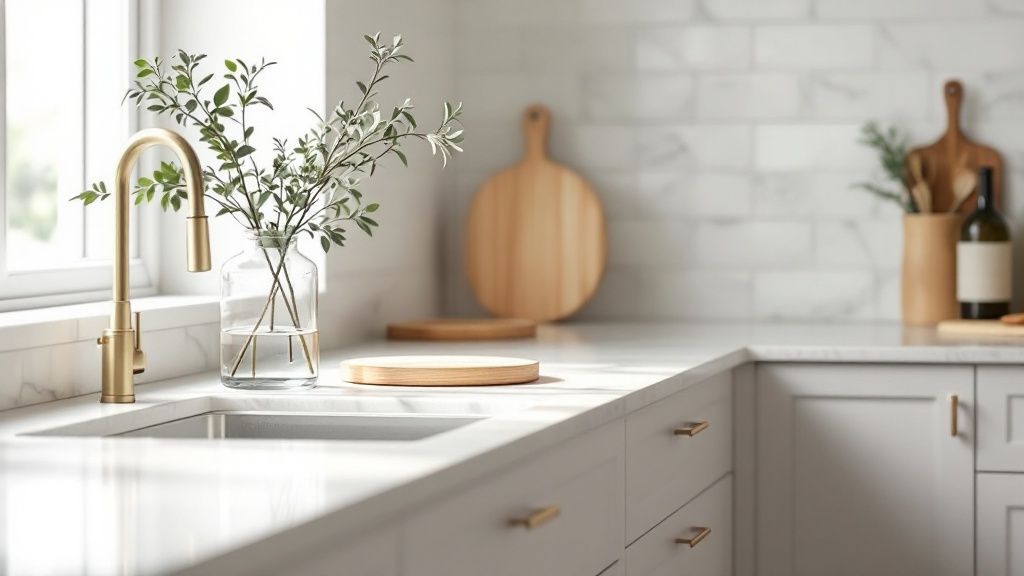
The Four Pillars of Kitchen Organisation
To create a system that actually lasts, we need to focus on a solid framework. Think of it like building a house – each pillar supports the next, creating a structure that's both logical and, most importantly, easy to keep up.
To simplify this approach, I've broken it down into what I call the four pillars. Each one tackles a different aspect of creating a truly functional kitchen.
By tackling each of these pillars one by one, you're not just tidying up; you're building a system that makes daily life that little bit simpler. It’s an approach that puts function first.
A truly organised kitchen isn't one that's perfectly styled for a photo; it's one where you can find what you need, when you need it, without thinking twice. This is about making your daily life simpler and more enjoyable.
The Great Kitchen Clear-Out Method
Before you can even think about clever storage solutions or perfectly organised zones, you need a clean slate. Real, lasting kitchen organisation starts with a proper clear-out, leaving you with only the things you actually use, need, and genuinely love. This isn’t just a quick tidy-up; it’s about taking back control of your space.
Let’s be honest, we’ve all been trapped by the “what if I need it someday?” question. It’s the single biggest reason cupboards overflow and drawers become a chaotic mess. We're going to face that head-on with a simple, effective strategy that makes those tough decisions much easier.
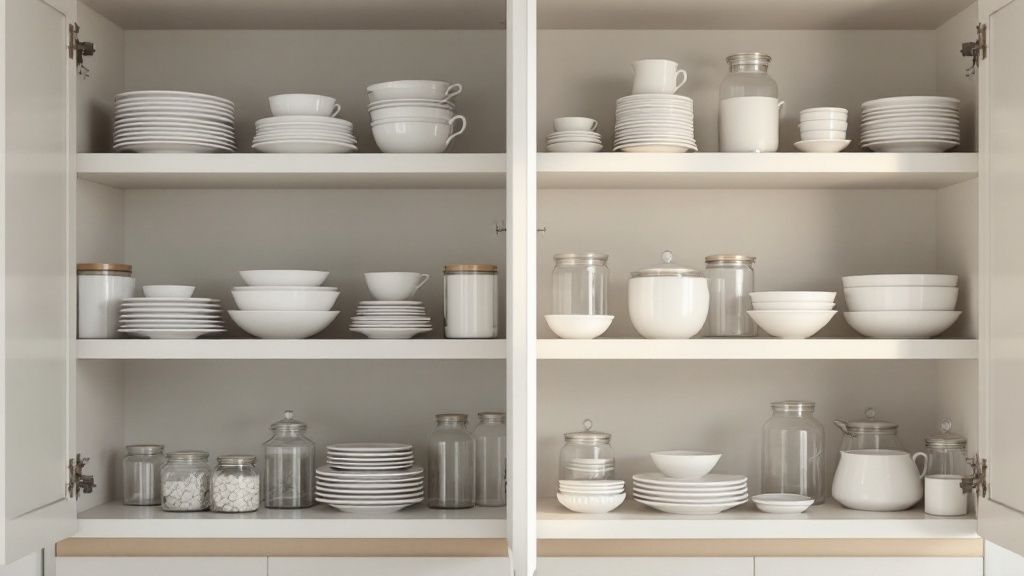
Embrace the Four-Box System
First things first, get yourself four boxes (or just create four distinct piles) and give them clear labels: Keep, Relocate, Donate/Sell, and Bin. This simple system is brilliant because it stops you from just shifting clutter around the room. Every single item you pick up has to be assigned to one of these categories, forcing you to make a decision.
- Keep: This is for items you use regularly that truly belong in the kitchen.
- Relocate: We all have them—things that have ended up in the kitchen but belong somewhere else. Think piles of mail, stray keys, or the kids' homework.
- Donate/Sell: For all those perfectly good items you just don’t use anymore. That bread maker you used twice? The duplicate set of measuring cups? Give them a new life.
- Bin: Be ruthless. Anything broken, expired, or past its best goes straight in here.
This structured approach is something professional home stagers swear by. In fact, if you're tackling more than just the kitchen, our guide on how to stage a home for sale dives into similar principles for making any space feel open and appealing.
Tackling Common Clutter Zones
To avoid feeling completely overwhelmed, start small. Pick one drawer or a single shelf. That's it. When you tackle the utensil drawer, for example, pull everything out and spread it on the counter. Do you really need three vegetable peelers or four slightly different whisks? Probably not.
My favourite trick is to think of the drawer or cupboard as a finite "container." Your job is to fill it with your most-used and best-loved items first. Once that container is full, anything left over is officially excess. This reframes the decision and removes the guilt—you're simply working within the physical limits of your kitchen.
Think about that dreaded collection of mismatched food containers. Get them all out and start matching every lid to a base. Any "orphans" or stained, warped containers go directly into the bin pile. It's this kind of systematic, logical approach that builds momentum and makes the whole project feel achievable. You're laying the groundwork for an organised kitchen that actually stays that way.
Designing Kitchen Zones for an Effortless Workflow
Right, you’ve cleared out the clutter. The next step is to build a smarter system from the ground up. A truly functional kitchen is all about flow, and the secret to achieving that is zoning. It's a simple but incredibly effective practice: group related items together based on the task you're doing. This turns your kitchen into an intuitive workspace where everything you need is right where you expect it to be.
The whole point is to cut down on the steps you take. You'll spend less time trekking from one side of the kitchen to the other and more time actually enjoying the process of cooking or baking. Think of it as creating a logical path for your daily routines, and the best part is, this approach works in any kitchen, no matter the size or layout.
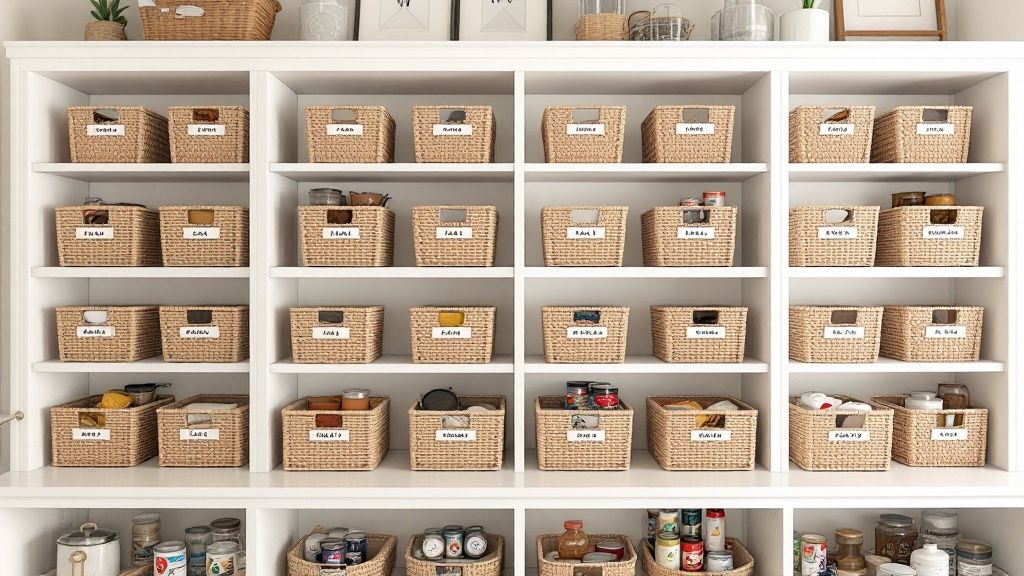
The Five Essential Kitchen Zones
To get started, it helps to think of your kitchen as a collection of activity hubs. Most kitchens can be broken down into five key zones, each serving a specific purpose.
- Everyday Zone: This is for all your daily-use items. Think plates, bowls, glasses, and cutlery. I always recommend storing these as close to the dishwasher or drying rack as possible. It makes unloading a complete doddle.
- Cooking Zone: Everything you need to actually cook should live right by the hob and oven. We're talking pots, pans, baking sheets, cooking utensils, and your most-used spices. Keeping oils and seasonings in a cabinet right next to the cooker is a small change that makes a huge difference when you're in the middle of a recipe.
- Pantry Zone: This is home base for all your non-perishable food. Tinned goods, pasta, cereals, and snacks should all be kept together. When they’re consolidated in one cupboard or on a set of shelves, you can see what you've got in a single glance.
- Cleaning Zone: A simple one, this. Keep all your cleaning supplies under the sink. Consolidate your washing-up liquid, sponges, bin bags, and surface sprays into this one spot to keep things tidy and accessible.
- Preparation Zone: Here's where you'll want your knives, chopping boards, and mixing bowls. Small appliances you use for prepping, like a food processor, should live here too. The ideal spot for this zone is on a clear stretch of worktop, preferably between the fridge and the sink.
This kind of logical layout is more important than ever. With open-plan living being so popular, our kitchens are becoming social hubs, not just functional spaces. It's no surprise that the UK kitchen furniture market is projected to reach USD 2.5 billion by 2025, driven by this desire for beautiful, multifunctional layouts. You can read more about this growing market on Mordor Intelligence.
The Kitchen Work Triangle
You might have heard of the "kitchen work triangle." It's a classic design principle that connects your three main work areas: the cooker, the sink, and the fridge. The real magic happens when you position your key zones around this triangle to create a seamless workflow. For instance, your Preparation Zone is most efficient when it's located between the fridge (where you get the ingredients) and the cooker (where they end up).
A well-placed kitchen island can be a fantastic way to anchor your work triangle while adding valuable prep space. If you're thinking about adding one, we've got plenty of inspiration in our guide to kitchen island design ideas.
Remember, the goal of zoning isn’t to create rigid, unchangeable rules. It’s about creating a personalised system that reflects how you actually use your kitchen. Adjust the zones to fit your space and your cooking style.
Mastering Smart Storage Solutions
Now that you've mapped out your kitchen zones, we can get to the really satisfying part: making every inch of your space work for you. This isn't just about stashing things out of sight. It's about creating a system where everything is visible, easy to grab, and a genuine pleasure to use. Let's look at some clever, practical ways to tame your cupboards, drawers, and even your walls.
Good storage is a game-changer. It can completely transform how you feel about being in your kitchen. When you can see what you have and get to it easily, you cut down on food waste and shave precious minutes off your meal prep. It's the difference between a kitchen that fights you and one that feels like a reliable partner in crime.
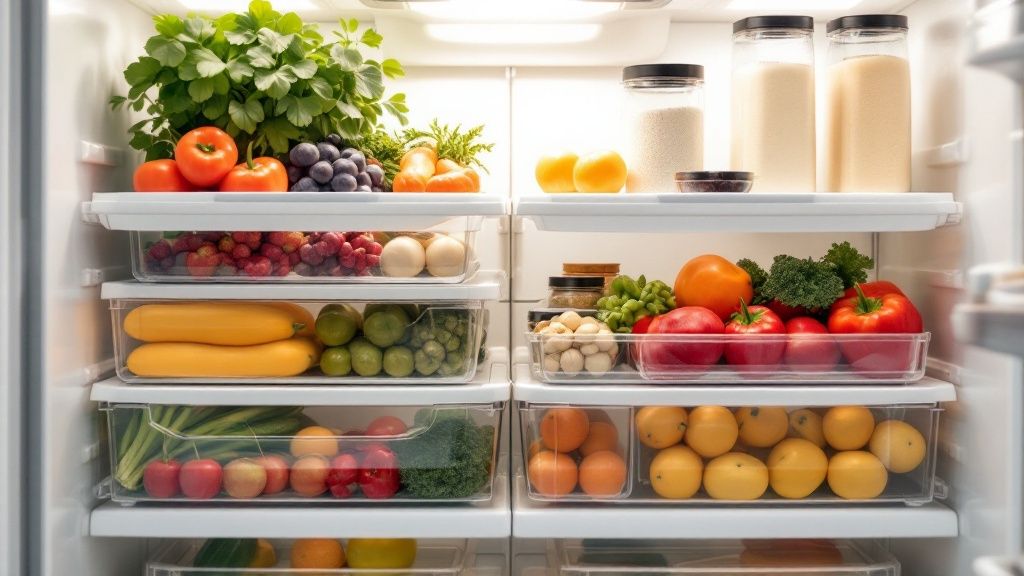
Maximise Your Cupboards and Drawers
First, let's tackle the inside of your cabinets. We all know how deep cupboards can become black holes, swallowing up items you completely forget you own. The trick is to bring the contents out to meet you, so you can see everything without having to pull the whole shelf apart.
- Pull-Out Shelving: If you do one thing, consider this. Installing sliding shelves in your lower cabinets makes reaching heavy pots, pans, or the stand mixer an absolute dream. No more getting on your hands and knees.
- Turntables (Lazy Susans): These are brilliant for awkward corner cupboards or deep pantry shelves. A quick spin brings that jar of chutney right from the back to the front, ensuring nothing gets lost in the abyss.
- Drawer Dividers: Stop the utensil drawer chaos. Adjustable dividers are fantastic for keeping everything from your cutlery to odd-shaped gadgets neatly separated and instantly findable.
These kinds of thoughtful upgrades are becoming standard as more of us look to create truly functional homes. The 2025 UK Houzz Kitchen Trends Study highlighted a major shift in renovation spending, with 92% of homeowners upgrading worktops and prioritising quality materials. It's clear that a kitchen that works well is just as important as one that looks good.
Think Vertically to Reclaim Space
When you've run out of shelf and drawer space, the only way is up. Your walls and the inside of cupboard doors hold a surprising amount of untapped storage potential—a real lifesaver in smaller UK kitchens where every centimetre counts.
Here are a few ways to go vertical:
- Wall-Mounted Rails: A simple rail with a few S-hooks is perfect for hanging utensils you use all the time, your favourite mugs, or even small pans. It frees up drawer space and keeps your essentials within easy reach.
- Magnetic Strips: They aren't just for knives! A magnetic strip can hold spice tins or any metal-handled tools, getting them off your valuable worktop.
- Pot Racks: Whether it’s mounted on the ceiling or the wall, a pot rack can be a stylish and seriously practical way to store bulky cookware, turning it into part of your kitchen's decor.
For a deeper dive into making your layout work harder, check out our guide packed with more clever kitchen storage ideas.
Choosing the right storage can feel overwhelming, so I've put together a quick comparison to help you decide what might work best for your space and budget.
Choosing the Right Storage Solution
Each option has its place, and often a combination of a few is what really brings a kitchen together. Start with the area that frustrates you the most—you'll be amazed at the difference one or two small changes can make.
One of the single most effective habits you can adopt is decanting dry goods—think pasta, rice, flour—into clear, airtight containers. It doesn't just keep food fresher for longer; it lets you see your stock levels at a glance. This makes writing a shopping list a breeze and stops you from accidentally buying a third bag of lentils.
Building Habits to Keep Your Kitchen Organised
An organised kitchen isn't something you achieve once and then forget about. It's the result of small, consistent actions that stop clutter from ever taking hold in the first place. The real secret to lasting order isn’t a weekend-long blitz, but a few simple habits woven into your daily life.
By putting these little routines in place, you can maintain that calm, functional space for good. We're aiming for progress here, not perfection. It's all about building a system that prevents the mess from returning, making your kitchen a consistently enjoyable place to be. This is where you truly start to reap the rewards of all your hard work.
The Power of Small, Daily Routines
The trick is to make these actions so small they feel almost effortless. Instead of facing a mountain of mess at the end of the week, you're just dealing with things in tiny, manageable chunks as you go. It’s a proactive approach that keeps everything under control without ever feeling like a chore.
A couple of game-changing habits to start with are:
- The 10-Minute Nightly Reset: Before you call it a night, set a timer for just ten minutes. Use this time to wipe down the worktops, put away any stray items, and load the last few dishes into the dishwasher. It’s amazing what you can get done, and you’ll wake up to a fresh start every morning.
- Clean As You Go: This one's a classic for a reason. While you’re waiting for the kettle to boil or for something to finish baking, wash a few utensils or tidy a drawer. When you build cleaning into the cooking process itself, you prevent that big pile-up of work later on.
When tidying becomes part of your daily rhythm rather than a separate, dreaded task, you’ll find that keeping an organised kitchen takes surprisingly little effort. It’s about working smarter, not harder.
Systems for Managing Clutter and Food Waste
Beyond the daily tidy-up, a couple of simple rules can make a massive difference in managing the flow of items in and out of your kitchen. These systems are all about preventing new clutter from creeping in and making sure you actually use what you already have.
The "one-in, one-out" rule is brilliant for keeping new purchases in check. Every time you bring a new item into the kitchen—whether it’s a new mug, a gadget, or a serving dish—an old one has to leave. This is especially important today. The UK kitchenware market is valued at around USD 3,375.9 million in 2024 and is still growing, partly because over half of us are trying new cooking trends and buying the tools to match. Following this rule lets you enjoy new things without adding to the clutter. You can discover more insights about UK kitchenware market trends on grandviewresearch.com.
It’s also a great idea to schedule regular pantry check-ins. Once a month, just take five minutes to scan your shelves for anything nearing its expiration date and plan a few meals around those items. It’s a simple habit that cuts down on food waste and saves you money. While you’re in there, a quick wipe of the shelves helps maintain that clean feeling, much like keeping your floors pristine. For tips on that, check out our guide on how to clean engineered hardwood floors.
Finally, getting the whole family on board is crucial for long-term success. Assign simple, age-appropriate tasks, like asking the kids to put their own plates in the dishwasher. When everyone knows where things belong and helps with the daily reset, the load is lighter for everyone, and your beautifully organised kitchen becomes a shared achievement.
Got Questions? We’ve Got Answers
Even with the best plan in the world, you’re bound to hit a few snags when you start reorganising your kitchen. Let’s tackle some of the most common questions that pop up during a kitchen overhaul. Think of this as your go-to guide for navigating those tricky spots and fine-tuning your new setup.
How Do I Organise a Very Small UK Kitchen?
When you're working with a smaller UK kitchen, every square inch counts. The trick is to start thinking vertically. Your walls are your best friend—install shelves, magnetic knife strips, or even a hanging pot rack to get bulky items off the precious worktop space. It’s a simple change that makes a huge difference.
Multi-functional items are also a lifesaver. A set of nesting bowls that takes up the space of just one, or an over-the-sink chopping board that adds a bit of extra prep area, can be brilliant. And don't forget the inside of your cupboard doors! They're the perfect spot for small items like spice jars or measuring spoons. For a bit of flexible storage, a slimline trolley can be wheeled in when you need it and tucked away when you don't.
If there's one piece of advice to take away for a small kitchen, it's this: be absolutely ruthless when you declutter. When space is this tight, you just can't afford to hang onto things you don't truly need.
What Is the Best Way to Organise Pots and Lids?
Ah, pots and lids. The classic kitchen storage nightmare. One of the most effective solutions I've found is to stack the pots in a deep drawer, placing pan protectors between each one to stop them from getting scratched up. If you have cupboards instead of drawers, a pull-out organiser designed for cookware can make reaching that pan at the back much less of a hassle.
As for the lids, storing them separately is a game-changer. You can buy a dedicated lid rack and mount it on the inside of a cupboard door, which keeps them visible and neatly contained. Here’s another great trick: pop a simple tension rod inside a deep drawer. This lets you stand the lids up vertically, sorted by size, so you can grab the right one in an instant without having to unstack a wobbly tower of pans.
How Often Should I Reorganise My Kitchen?
A full-scale, top-to-bottom reorganisation like the one we've outlined is something you'll probably want to tackle once a year. It’s a chance to do a proper reset and make sure your system is still working for you and your family. But the real secret to keeping things in order is regular, low-effort maintenance.
I always recommend a quick 10-minute tidy-up each evening. Just clearing the surfaces and making sure the sink is empty makes a world of difference when you walk in the next morning. On top of that, a monthly once-over of your pantry and fridge to weed out expired items will stop clutter from creeping back in. A seasonal review every three or four months is also a great habit to get into, just to see if your zones need a little tweak.
Are Expensive Storage Containers Worth It?
Let's be honest, a pantry filled with perfectly matched, high-end containers is beautiful. But is it necessary? Absolutely not. You can achieve fantastic organisation on a budget. The two most important things are visibility and airtightness, and you don't need to spend a fortune to get them.
Simple glass jars, repurposed jam jars, or clear plastic containers from the supermarket do the job perfectly well. The real goal is to get items out of their awkward, half-empty packaging so you can see exactly what you've got. What matters far more than the brand is consistency in shape. Sticking to all square or rectangular containers, for instance, is much more space-efficient for stacking than using round ones, which inevitably leave gaps.

